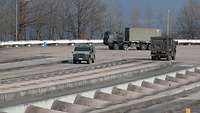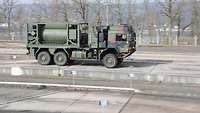Test Course Quartet – Trier gets its fourth driving robot
Equipment, Information Technology and In-Service Support- Date:
- Place:
- Trier
- Reading time:
- 3 MIN


On 7 March, the Bundeswehr Technical Center for Land-Based Vehicle Systems, Engineer and General Field Equipment (WTDWehrtechnische Dienststelle 41) introduced an additional driving robot: Now, four vehicles roll onto the test course only 20 seconds apart from each other to conduct the trials at WTDWehrtechnische Dienststelle 41 in Trier. None of the vehicles have any occupants – they drive in an automated manner.

The driver-less vehicles drive on different surfaces. A driving robot is behind the wheel of each of these vehicles.
Bundeswehr/Dirk BannertThe first system was introduced more than twelve years ago – the new driving robot is an extension of the existing systems. On the one hand, it complements these system, but it is also intended as a system to fall back on. With this addition, it is now possible to perform trials with four vehicles at the same time. The driving robots are installed in the vehicles to be tested, which will then be steered by these robots.
The new system is equipped with improved software compared to the previous system. Also, the control system computer has been replaced: A more powerful computer was needed to account for the increased data volume that is generated due to the additional robot.
The test tracks are covered with different surfaces to ensure that each track exerts a certain type of strain on the vehicle: WTDWehrtechnische Dienststelle 41 has it all, from corrugated tracks to bumpy roads. This is to very deliberately test the vehicles’ boundaries. In an actual emergency, our soldiers must be able to rely on the vehicles.

Impressive: A truck without occupants is being driven on a concrete road
Bundeswehr/Dirk BannertOccupants are given a proper shake during a ride on the tracks. This is why the wheeled vehicles are no longer steered by employees of WTDWehrtechnische Dienststelle 41. Instead, driving robots have been performing this task for several years now.
There are good reasons for this: A person may spend a maximum of half an hour in a vehicle that is tested on the tracks – for reasons of occupational safety and health. "Sitting behind the wheel of one of those trucks really hurts," Peter Fritzen says, pointing to one of the two trucks being steered by a driving robot.
Together with Gerd Zimmermann, Fritzen is responsible for the driving robots at WTDWehrtechnische Dienststelle 41. If employees were to perform this task, the drivers would have to be replaced during the trials. This is incovenient and takes up too much time. “Also, a person would instinctively evade the potholes. So, with a human driver behind the wheel, it would be almost impossible to take the exact same route twice," says Zimmermann during the demonstration of the four driving robots.
The driving robot can accurately reproduce previous trials: The route is displayed on a screen inside the vehicle. Route and speed are controlled in detail by a control system computer. The control station is located at the edge of the course in an elevated container. The entire course is visible from up there.
Thanks to the additional driving robot, up to four vehicles can now be tested at the same time. This saves time and is a relief for the personnel of the Bundeswehr technical center.
"The vehicle test data must be watertight. You can even recreate situations from six years ago – simply by way of a flash drive," Fritzen says. This way, they can check whether a deficiency has been corrected.
What is more, the whole system is also efficient. "It is possible to reduce the number of trials by an order of magnitude." This means that instead of 40,000 kilometers, only 4,000 kilometers of driving are required, according to Fritzen. This corresponds to the mileage a vehicle typically drives between two major repairs.
At the end of the trial, Zimmermann points out something curious: "The Bundeswehr uses the driving robots in a somewhat odd manner. Originally, their purpose was entirely different. They were developed to test driver assistance systems – for example for the testing of vehicle distance sensors." At WTDWehrtechnische Dienststelle 41, the driving robots performing the trials are very much appreciated – in fact, they have become indispensable.
by Heike Westhöfer